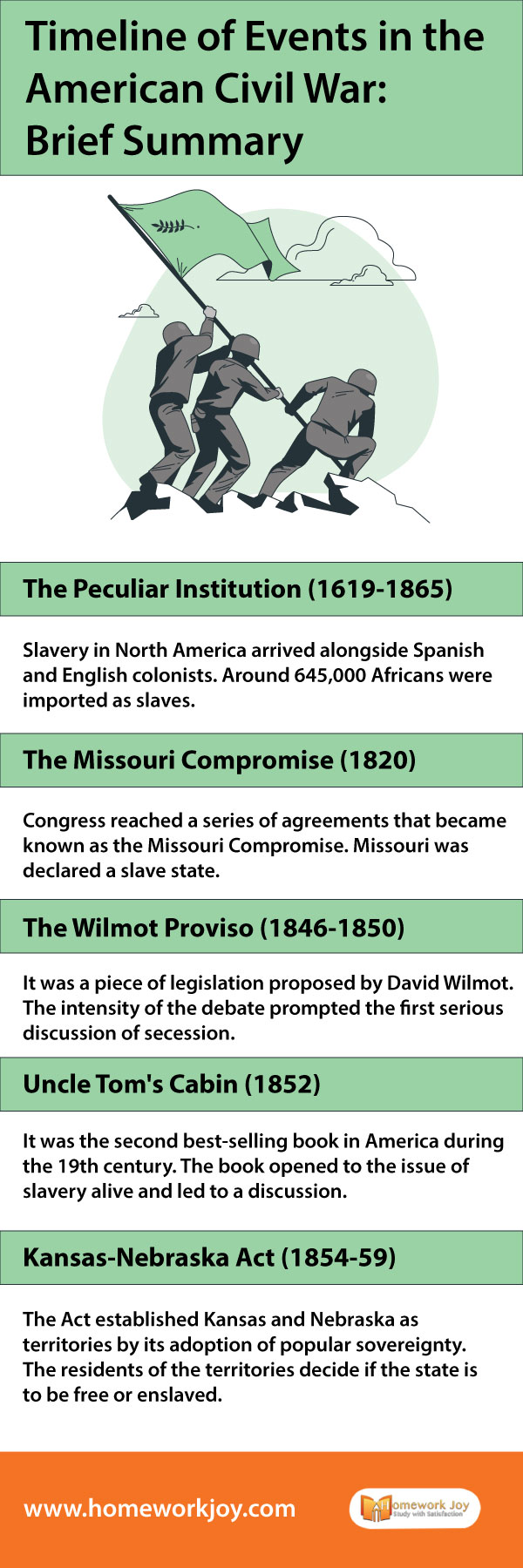American Civil War is also known as the War between the states. It was a four-year war between the United States and 11 Southern states. The American Civil War was the struggle between advocates and opponents of slavery. This sectional conflict between Northern states and Slaveholding Southern states was followed by a series of Compromises. But the issue of the extension of slavery to the western states had reached a boiling point.
The election of Abraham Lincoln who was anti-slavery precipitated the secession of 11 Southern states, leading to a civil war.
Events in the American Civil War
Series of events took place in the American Civil War. Some of them are:
- The Peculiar Institution (1619-1865)
Slavery in North America arrived alongside Spanish and English colonists. Around 645,000 Africans were imported as slaves. The British colony of Georgia banned slavery from 1735-1750. However, it remained legal in the other twelve countries. After the American Revolution, the northern states passed emancipation laws. The sectional divide was visible as the South was committed to slavery.
- The Missouri Compromise (1820)
After Louisiana Purchase, Congress had to establish a policy to guide the expansion of slavery into the new western territory.
Congress reached a series of agreements that came to be known as the Missouri Compromise. Missouri was declared a slave state. In the contrary, Maine was admitted as a free state, preserving the Congressional balance.
- The Wilmot Proviso (1846-1850)
It was a piece of legislation proposed by David Wilmot. If passes, the Proviso could outlaw slavery in territories acquired by the United States as a result of the war. Wilmot spent two years fighting for this Proviso. All attempts failed, but the intensity of the debate prompted the first serious discussion of secession.
- Uncle Tom’s Cabin (1852)
Harriet Beecher Stowe’s exploration of slaves’ life was a cultural sensation. Northerners felt it was an eye-opener to the horrors of slavery. On the contrary, Southerners protested his work was slanderous.
It was the second best-selling book in America during the 19th century. The book opened to the issue of slavery alive and led to a discussion.
- Kansas-Nebraska Act (1854-59)
The Act established Kansas and Nebraska as territories by its adoption of popular sovereignty. Under sovereignty, the residents of the territories decide if the state is to be free or enslaved. Residents of the North and South poured into Kansas, hoping to swell the numbers on their side of the debate. Abolitionist John Brown came to Kansas to fight the forces of slavery.
- Abraham Lincoln election (1860)
Abraham Lincoln was elected as the president despite being not included in May Southern ballots. His party has an anti-slavery outlook which struck fear among the Southerners.
The Ceasefire Agreement commenced with the Army of Northern Virginia at Appomattox Court House, by General Robert E. Lee. The agreement brought the hostilities of the American Civil War to a close.
If you need more help related to similar topics, take instant homework help from our professors.
